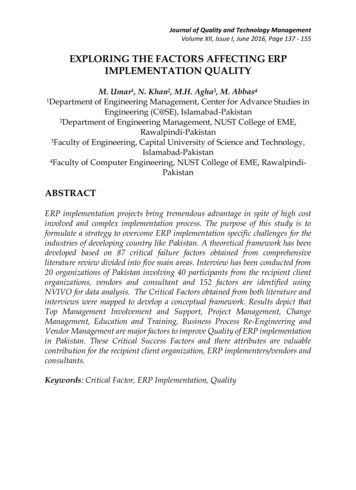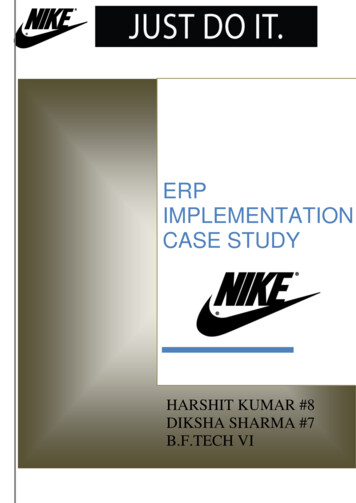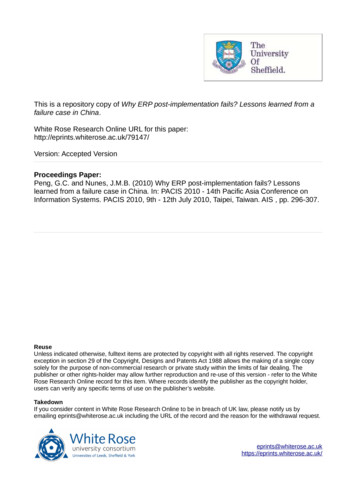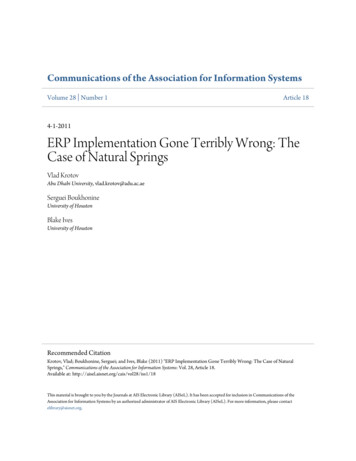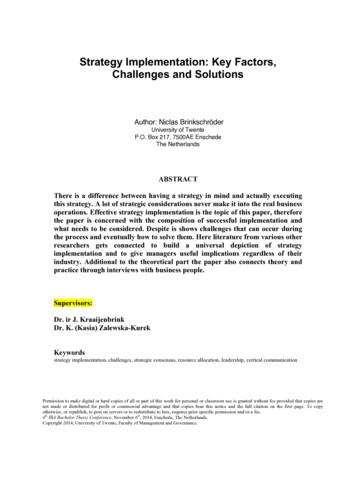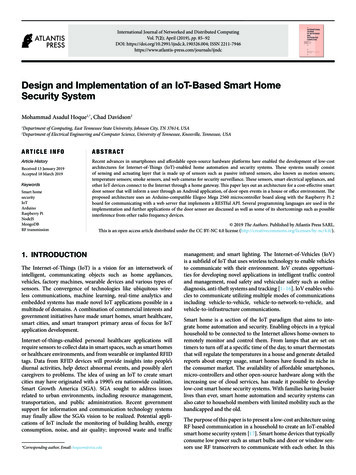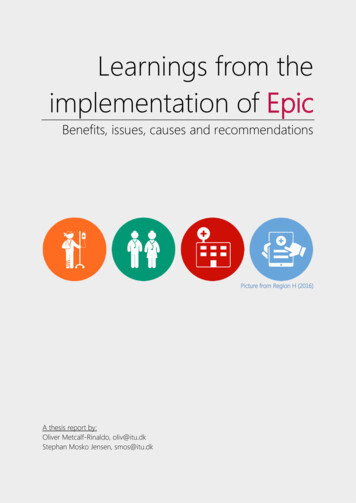
Transcription
Learnings from theimplementation of EpicBenefits, issues, causes and recommendationsPicture from Region H (2016)A thesis report by:Oliver Metcalf-Rinaldo, oliv@itu.dkStephan Mosko Jensen, smos@itu.dk
Supervised by:Søren Lauesen, slauesen@itu.dkDigital Innovation & ManagementIT University of CopenhagenDecember, 2016
Table of contentsPreface .31. Executive summary.41.1 Scope of the implementation .41.2 Observed issues at Herlev/Gentofte Hospital .41.3 The causes for the observed issues .51.4 Recommendations for implementing Epic .62. Investigating the implementation of Epic .72.1 Important stakeholders .72.2 Interviews conducted .82.3 Documents scrutinized .83. From multiple systems to one integrated solution .93.1 The old systems and workflows .93.2 Envisioning one system, one record . 103.3 Business case and expected benefits . 113.4 Tender and procurement process . 123.6 Developing clinical and administrative content . 133.5 Technical development . 143.6 Implementation plan . 153.7 Harvesting the benefits . 164. Epic in use . 174.1 Examples from daily use . 174.2 The first public responses from users. 195. Issues observed at Herlev/Gentofte Hospital . 215.1 Troublesome documentation and requisitions processes . 225.2 Inconsistent and less detailed medical records. 235.3 Long response time when reconciling medicine . 245.4 Requisitions and prescriptions disappearing. 245.5 Limited use of clinical guidelines . 255.6 Lack of structured data for research . 275.7 Incorrect coding of treatments and services . 271
6. The effects on the business case . 296.1 Less effective processes and work procedures . 306.2 Improved patient safety but lack of standardization . 316.3 No economic benefits by consolidating systems . 316.4 Incorrect basis for budgetary planning . 327. What caused the issues? . 337.1 Lack of qualifications among Subject Matter Experts . 347.2 Poor management of user involvement . 347.3 Poor training in the system . 367.4 Lack of ownership of business critical components . 377.5 Domain specific components incompatible with Epic. 387.6 System deployed without proper testing . 397.7 Vision does not create win-win situations . 407.8 Insufficient organizational change management . 417.9 Clinical and administrative content not being optimized . 438. Recommendations . 458.1 Take responsibility for realizing the benefits in the programme . 468.2 Implement organizational changes incrementally . 478.3 Focus on the benefits when building content . 478.4 Implement local changes and adjustments . 488.5 Be flexible about changing the go live date . 499. References . 5050.6 pages of 2,400 character with spaces2
PrefaceThe report which you are about to read is a master thesis crafted by Stephan Mosko Jensen and OliverMetcalf-Rinaldo at the IT University of Copenhagen. It is based on four months of empirical research whichwas conducted between September and December 2016. Data from several public articles and 19interviews with representatives from key stakeholder groups, were analyzed and processed. More than 400people have been involved in the procuring-, developing- and implementation process, and by the exit of2017 the total number of users will exceed 35,000 clinical workers. Thus, our empirical data only covers asmall fraction of the total knowledge held by all the people involved. Some may have entire differentexperiences than what is described in this report, and some of the issues and causes presented may havebeen handled by the programme management, the hospitals or the clinical personnel after this report wasconcluded.All the informants who have contributed to this research, have been presented with the report and havehad the opportunity to comment and give feedback. The clinical personnel are in general agreeing with theconclusions presented in the report and regard it as being a representative account of the implementationof Epic. However, the management at HGH, the region and the programme organization regard it as being aone sided and mainly negative account of the implementation. Their critique is especially aimed at theweight given to the statements of the clinical personnel and the conclusions on the poor prospects ofharvesting the benefits described in the business case. The goal of this report is not to blame any of thepeople involved but to present valuable insights and learnings from the Danish implementation of Epic.Good reading.3
1. Executive summaryThis paper investigates the Danish implementation of the Electronic Health Record (EHR) system Epic atHerlev/Gentofte Hospital (HGH). It outlines the prospect of harvesting the benefits described in thebusiness case, along with recommendations for authorities and hospitals who are considering to acquireEpic.1.1 Scope of the implementationIn 2012 Region H and Region Sjælland established the programme organization Sundhedsplatformen to beresponsible for the procurement, development and implementation of a new EHR system. The totalinvestment amounts to 2.8 billion DKK, involves 2 regions, 17 hospitals and affects 40,000 healthcareprofessionals. It is based on a business case which prescribes a world class healthcare sector by, providingmore effective processes and work procedures, improving the quality of care and lowering IT operationscost. The repayment period is expected to be 9-11 years from the programme initiation in 2012. The tenderwas completed in 2013 and Epic Systems Corp. was chosen to deliver the commercial of the shelf EHRsystem Epic. The first hospital went live with Epic in May 2016 and all 17 hospitals are expected to have thesystem implemented by December 2017.1.2 Observed issues at Herlev/Gentofte HospitalWith the Danish implementation of Epic follow new processes and distribution of roles and tasks at thehospitals. The most significant is the abolishment of dictation which means that all doctors will have towrite medical records themselves. Moreover, it introduces paperless and standardized work processes andprocedures which have to be implemented in all departments. When the system went live at HGH severalissues were observed. Some have an impact on the clinical practice while others affect the strategic goals ofthe regions. The following seven observed issues have a direct impact on one or more potential benefitsdescribed in the business case.5.15.25.35.45.55.65.7Troublesome documentation and requisitions processesInconsistent and less detailed medical recordsLong response time when reconciling medicineRequisitions and prescriptions disappearingLimited use of clinical guidelinesLack of structured data for researchIncorrect coding of treatments and servicesThe most significant and persistent impact on the business case stems from the documentation andrequisitions processes which leads to lower productivity in the outpatient clinics. In some departments theproductivity is at 80%. The tools developed for supporting these processes does not compensate for theextra workload required by the doctors. It was expected that 75% of the economic benefits were to berealized by improving the clinical and administrative processes but this is far from being fulfilled. Moreover,during the first couple of months, technical issues led to long response time and requisitions disappearingwhich decreased the efficiency even further. However, this is currently being fixed as these issues are highly4
prioritized by the programme. The potential of improving the quality of care has been accomplished insome areas but lack in others. Patient safety has improved due to the consolidation of 30 systems whichleaves less room for errors as the amount of information being transferred between systems and personnelis limited. However, the aim of providing the best known treatment for all patients in the two regions is farfrom fulfilled as the clinical personnel often deviates from the clinical guidelines and provide unstructureddata, unfit for research purposes. Furthermore, a considerable amount of incorrect coding of services andtreatments will require unexpected resources to correct as it serves as an incorrect basis for thedistribution of finances between the hospitals. A full overview of the issues and benefits can be found inchapter 6.1.3 The causes for the observed issuesThe observed issues were caused by several different factors which are of both technical, strategic andorganizational character. Each cause has a direct relation to one or several issues which is elaborated inchapter 5. The following nine causes are described in detail in chapter 7.7.17.27.37.47.57.67.77.87.9Lack of qualifications among Subject Matter ExpertsPoor management of user involvementPoor training in the systemLack of ownership of business critical componentsDomain specific components incompatible with EpicSystem deployed without proper testingVision does not create win-win situationsInsufficient organizational change managementClinical and administrative content not being optimizedMany of these causes can be traced back to the decision of keeping the go live date which was establishedby the programme in 2012. The development of the system was delayed which affected the training andleft limited time for testing the system’s functionality, the new workflows and the clinical content. Theprocess of developing clinical and administrative content for Epic has included a considerable amount ofuser involvement yet the content still fails to support the clinical practice efficiently. This is due to the lackof qualifications among Subject Matter Experts and poor management of user involvement as well as alimited optimization of the content after the system has been deployed.After go live the integrations to the external systems FMK and Labka were not working properly and theusers experienced reconciliation issues with FMK and orders to Labka disappearing. This was caused by thelack of ownership of the business critical components and incompatibility issues with the technicalarchitecture of Epic. Furthermore, the system was deployed without proper testing because of the tightdeadline which resulted in these issues not being discovered before go-live.The individual users and the different departments at HGH were insufficiently prepared for the new workpractices and distribution of roles imposed by the implementation of Epic. The training of end users hadlimited effect as the system was not ready for being demonstrated properly due to the delays in thedevelopment process. Furthermore, as the system does not provide benefits for the clinical personnel and5
due to insufficient change management, the clinical staff did not take ownership of the system and doesnot use it as intended.1.4 Recommendations for implementing EpicWe have compiled a list of recommendations which can be used in other Epic implementations in order tominimize risk and strengthen the prospect of gaining the benefits of the system. Each recommendation is asolution to one or more of the causes mentioned above which is further elaborated in chapter 8.8.18.28.38.48.5Take responsibility for realizing the benefits in the programmeImplement organizational changes incrementallyFocus on the benefits when building contentImplement local changes and adjustmentsBe flexible about changing the go live dateAs seen in the Danish implementation of Epic it is difficult to introduce a new EHR system withoutcomplications. Replacing several IT systems and paper based workflows introduces potential benefits aswell as risks of degrading the efficiency and quality of the health care services. Two other Europeancountries have acquired Epic, with mixed success. At Cambridge University Hospital the problems were sosevere that the hospital was put under administration. Radboud University Medical Center in Holland alsohad challenges with the implementation but has started harvest the benefits after 2 years of use. It isimportant for all stakeholders to be aware that such an implementation will impose significant changes tothe organization and it will take years of adjusting the system and work processes before the benefits canbe realized. A successful implementation depends on many factors, but we argue that end users have theprimary role as they are the one harvesting the benefits. If they do not perceive the system as beneficial fortheir work, they will not use it as intended which can take years to redeem.6
2. Investigating the implementation of EpicThis paper presents the results of a qualitative study of the implementation of the EHR system, Epic and itsimpact on the clinical practice at the Herlev/Gentofte Hospital (HGH) in Denmark. The study was carried outfrom September to November 2016, which is approximately 3 months after the first go live. Implementingthe system at all hospitals in the two regions spans from primo 2016 – ultimo 2017 and thus this study onlypresents learnings from the initial phase of the implementation. The primary focus has been on theimplementation at HGH but we have also included some insights from the coming implementations at theRigshospital and Nordsjællands Hospital. The findings presented in this paper are descriptions of the mostimportant decisions made by the different stakeholders, the rationale behind and the consequences whichthey have had on the clinical practice.2.1 Important stakeholdersImplementing Epic is a task which includes several actors. We have compiled the following model to showthe most important stakeholders and their contribution to the implementation in Denmark.Figure 1 - Stakeholders involved in the Danish implementation of Epic (self-made figure)7
2.2 Interviews conductedThe majority of this report is based on 19 qualitative interviews with different stakeholders who holdinsight into the procurement, development, implementation and use of Epic. Our informants have wishedto be anonymized and thus will not be cited in this paper. The findings presented in this paper representindividual stories and our assessment of their statements. The interviews have been conducted withrepresentatives from:Herlev/Gentofte HospitalClinical staffDepartment managementHospital managementNordsjællands HospitalClinical StaffProgramme organizationProgramme managementClinical content developmentTechnical developmentSubject Matter ExpertRegion HBusiness change managementRisk managementRadboudumc (Dutch Epic customer)Information management2.3 Documents scrutinizedWe have included several official documents and news articles to provide additional insights. They are usedboth as primary sources and to support the findings from the interviews. The documents are:Region HProgramme organizationPresentationsBenefits catalogueStatus reports and press releasesSummary of business case and
1.1 Scope of the implementation In 2012 Region H and Region Sjælland established the programme organization Sundhedsplatformen to be responsible for the procurement, development and implementation of a new EHR system. The total investment amounts to 2.8 billion DKK, involves 2 regions, 17 hospitals and affects 40,000 healthcare professionals.
